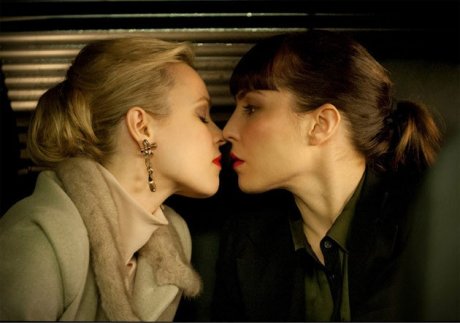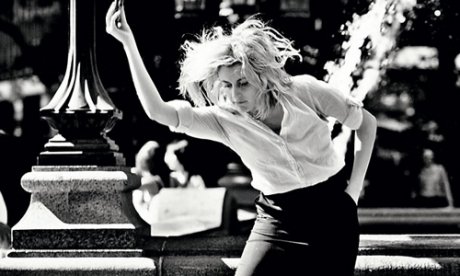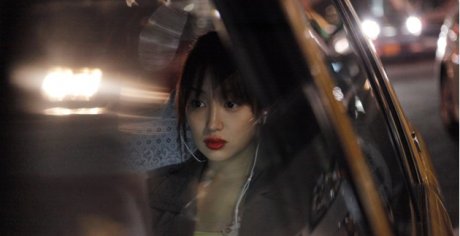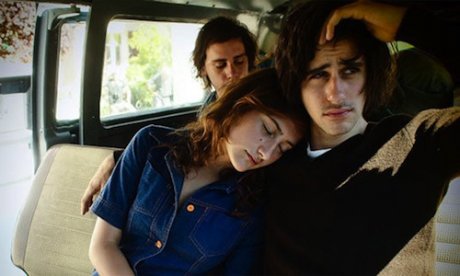It can be hard to divorce the experiential aspect of cinema from the film itself. This is most perceptible at a film festival, where every movie has been curated and prepared for presentation at a few public screenings, often attended by the filmmakers themselves. We enter a theater based on the promise of a certain glimpse of truth, brought within a contemplative space; and indeed, the Alice Tully Hall, a 1,000-seat chamber music hall somehow converted into a movie theater, may very well be the best place to see movies in New York. But things sometimes go awry, and the illusion is ruptured. Technology’s increasing tendency to cut out the middleman — in this case, the inevitability of digital projection — has proved to reduce the texture inherent in the cinematic apparatus, forcing our gaze directly into a virtual mirror.
Yet the films at the New York Film Festival, now in its 50th year, suggested this shift might in fact deepen our relationship with the mystique that got us into these seats. Some of them made film itself a subject, either as elegy (Holy Motors), memory (Tabu), or as a passive observer of new technologies (Nathaniel Dorsky’s April). Some used theater as an agent for transcending the past (You Ain’t Seen Nothin’ Yet, Caesar Must Die), while others confined cinematic space for a confrontation with death (Amour). One threw all perspective to the wind, literally (Leviathan). These films doubled back on themselves, forcing us outside of their self-contained worlds in order to let us find our own way in.
At the NYFF, a few-dozen films by world-class auteurs are shown beside those of younger upstarts, with each one, by sheer nature of inclusion, purporting to change the conversation. Even an entire sidebar dedicated to the seminal Cinéastes de notre temps documentary series highlighted the importance of dialogue, reflection, and self-contradiction in the lives and work of the great filmmakers. In general, these films themselves did much to challenge film as a medium, while also restoring the idea of childlike wonder and attraction that, for me, has become integral to my enjoyment of cinema. Having been a member of the press this year, I would still say that for my money, the NYFF is the best place to see movies.
Passion (Brian De Palma)

The hallmarks of Brian De Palma’s cinema du look — sweeping camerawork, narrative reflexivity, visual and verbal double entendres — are fully present in this gleefully old-fashioned psychodrama of high-business office politics, which doubles (oh, those doubles!) as a canny survey of modern technology’s manipulative power. A blonde (Rachel McAdams) and a brunette (Noomi Rapace) pithily jab at each other’s throats in a Berlin advertising agency, a dome of shimmering glass in which MacBooks, smartphones, and security cameras become agents of deception. As ever, De Palma’s images range from starkly artificial to gracefully restless, a stream undercut by the severe beauty of his actresses: the ghostlike McAdams and Rapace’s tight grin seem built from a century’s worth of repressed desires. Indeed, the film’s latter half turns dream-life into a shaggy dog story, lit through Venetian blinds, which finally unspools as one girl’s fantasy of entrapment, stuck in a reality where she can never truly get off. Who said De Palma isn’t a personal filmmaker? With the sultry score by De Palma vet Pino Donaggio and a typically mesmerizing split screen sequence, Passion finds the director delightfully riffing on himself.
Frances Ha (Noah Baumbach)

Noah Baumbach’s films are always set in the specific context of a particular urban environment, but though his recalcitrant characters are often hard to love, he rarely aims to stifle. Rather, his attention to colloquial detail, as well as his great sense of humor, gives the impression there is still a booming world outside of his characters’ self-absorption. In Frances Ha, Baumbach returns to NYC for his breeziest city symphony yet, a return to small-scale filmmaking that playfully rejects moral grandstanding in favor of loopy self-abandon. An aspiring dancer who can never catch a break, Frances (Greta Gerwig, who co-wrote the film) breaks up with her boyfriend and is kicked out of her girlfriend’s apartment, beginning a neighborhood- (and eventually globe-) trotting odyssey toward self-acceptance, whose chapters Baumbach designates with specific addresses. The aural world of the film underlines its pinball mobility, filled with self-deprecating appraisals and blunt dinner table talk (“I fucked her little brother! How do you know her?”), along with musical homages to Leos Carax and Georges Delerue. Yet Baumbach’s film manages to avoid becoming just a slew of references, as it joyously relays Frances’ freedom from responsibility while refusing judgment — a transient portrait of a modern girl who can afford to not take life seriously, if only for 90 minutes.
Like Someone in Love (Abbas Kiarostami)

“When you know you may be lied to, sometimes it’s better not to ask questions,” says a character in Abbas Kiarostami’s latest — a seductive piece of advice, ultimately problematic in its self-denial, but which placates the lives of drifting souls in this beautifully beguiling Tokyo story. Kiarostami pares down cinema as a vessel, his films unfolding in an eternal present wherein forms of static movement (long drives, window gazing) serve to abstract, and thus elevate, the dialogue between people. In Like Someone In Love, he resists traditional signifiers, moving slowly to define the frequencies of his characters against a muted, ambient soundscape, while trusting his audience to play a game of identification from the first shot. Why does Akiko, a student working as a late-night escort, ignore her grandmother’s calls? Why is the cheerful, aging professor an “important man”? Left unanswered, these questions become less urgent than the film’s clear delineation between layers of social identity, each of which masks a deeper need to avoid confrontation. But by the time the film’s soft tension shifts into full-on paranoia, it remains an endless surface delight, and proof that Kiarostami is still searching for new ways to refine visual storytelling.
Leviathan (Verena Paravel & Lucien Castaing-Taylor)

You’ve never seen a documentary like Leviathan, a galvanizing, uncompromising, and genuinely horrifying documentary on deep-sea-fishing in the North Atlantic. If its subject doesn’t sound terribly original, the film’s approach, limited to one boat’s graveyard shift, is wholly singular: shot entirely with GoPro digital cameras, a tiny water- and shockproof model, the directors attach them to the heads and bodies of ship crew, the sides of the boat during high winds, the inside of a slippery basin filled with dead fish, and other points of view that defy or distort an immersive perspective. Thoroughly avant-garde, this agitated technique is less fly-on-the-wall than fly-caught-on-sandpaper, a writhing and throbbing sensory assault that invigorates with ephemeral abstract imagery, while never obscuring the grisly, lugubrious tasks of hauling and gutting an endless, alien mass. With its aggressive soundscape of whirring motors and violent sloshing, I wouldn’t necessarily call Leviathan a pleasant experience, but it’s a film that could only have been made today, utterly forthright in its attempt to use digital technology to show us something we’ve never seen before.
Something In The Air (Après mai) (Olivier Assayas)

In 1971, a team of French filmmakers documenting the working class screen their work for a crowd of Italian revolutionaries, leading to a pointed inquiry from an audience member: shouldn’t revolutionary films employ revolutionary syntax? “One must speak the language of the people,” to paraphrase their answer, and we can assume Olivier Assayas agrees after watching his latest widescreen delight, a semi-autobiographical portrait of a group of French students struggling to hang onto their ideals, as politics and passions change over time. When his girlfriend/muse leaves to pursue life as a roadie, Gilles, a driven painter and aspiring filmmaker, becomes smitten with the ambitious Christine, following her to Italy over the summer after a legally risky mishap while vandalizing their school together. What begins as suspense fades into languor: lushly photographed, the film revels in its period detail, always giving a sense of the conscious present while underlining the existential limbo of his protagonists. Defined by their naïveté, Assayas curbs sentimentality, giving the film’s evanescent evocation of an era a vaguely elegiac and quietly devastating impact.
